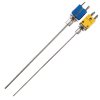S
Sorin
We are looking to buy a furnace (used) that is to be used for aerospace parts AMS2750 / BAC 5621 / (Nadcap) requirements implied.
The issue is that there is no way for us to add ports (holes) for SAT probe or additional resident thermocouples (for SAT).
The process sensors are Type K and I was thinking about installing double T/C (dual element - installed in the same metallic sheath). One type K which is the process sensor and one type N which will be the SAT resident.
I have to install 3 - control, hot, cold.
I looked through specifications and did not see anything that would prohibit me from doing so.
See picture attached - sample
What do you think?

The issue is that there is no way for us to add ports (holes) for SAT probe or additional resident thermocouples (for SAT).
The process sensors are Type K and I was thinking about installing double T/C (dual element - installed in the same metallic sheath). One type K which is the process sensor and one type N which will be the SAT resident.
I have to install 3 - control, hot, cold.
I looked through specifications and did not see anything that would prohibit me from doing so.
See picture attached - sample
What do you think?


 However, you really run across the issue of trying to do a post check on thermocouples prior to disposal.
However, you really run across the issue of trying to do a post check on thermocouples prior to disposal.